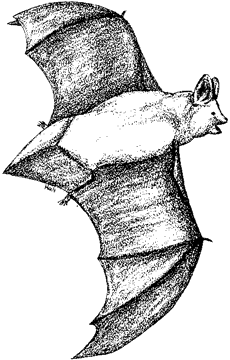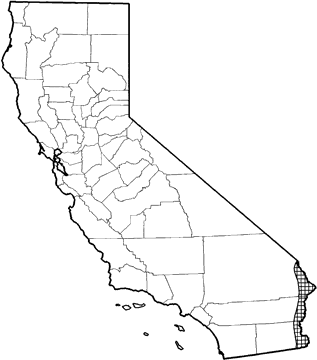
Cave Myotis
Distribution, Abundance, and Seasonality
Restricted, in California, to lowlands of Colorado River and adjacent mountain ranges, in San Bernardino, Riverside, and Imperial cos., although more common farther east. This species was once common, with several colonies of 1000 individuals in Riverside Mts. However, these colonies have experienced significant declines, and status in California is uncertain. Habitats occupied in California include desert scrub, desert succulent shrub, desert wash, and desert riparian.

Range Map
Specific Habitat Requirements
Feeding: This opportunistic species (Vaughan 1980) takes a variety of flying insects. Studies report large proportions of moths (Ross 1967, Hayward 1970) and beetles (Ross1967, Kunz 1974). Takes more hardshelled prey than do most myotis species. A strong flier with low maneuverability. It follows a regular path, often close to vegetation. Vaughan (1959) reported that it foraged close to riparian vegetation, 2-4 m (6-15 ft) away. Other studies report that forages from 4-12 m (12-50 ft) above ground early in evening, and 2-4 m(6-15 ft) above ground just before dawn. Juveniles forage closer to ground or vegetation than adults (Kunz1974). Lactating females have the highest food consumption.
Cover: A colonial cave-dweller, occurring in colonies of several thousand individuals in most of its range. Mines and buildings also may be used. Hibernation caves have high humidity, often with standing or running water and little air movement. Hibernating cave myotis may form clusters. Uses temporary night roosts.
Reproduction: Nursery colonies are in the hibernation cave or another cave. Occasionally other sites, such as bridges, are used. Males may be found in the maternity colony. Optimal sites are relatively warm, with little human disturbance.
Water: Probably required. Although the cave myotis can produce a concentrated urine (Geluso 1978), individuals usually drink soon after nightly emergence.
Pattern: Feeds along riparian vegetation, over water, between patches of riparianvegetation, and to a lesser extent over open areas.
Species Life History
Activity Patterns: Nocturnal. Hibernates. Emerges soon after sunset, earlier if sky is overcast. Consumes 80% of nightly diet in first 2 hr of activity. A second peak of activity occurs shortly before sunrise. Juveniles and lactating females emerge later, and juveniles may have unimodal activity patterns. Prefers high temperatures (18-26ÁC)(64-78Á F). In Arizona, hibernation begins in September or October, females before males.Nearly 1/4 of body weight lost during hibernation.
Seasonal Movements / Migration: Appears to be absent from California in winter and early spring (Stager 1939), suggesting migration to hibernacula further south, probably in Mexico.In Arizona, females leave in September and return in May; males leave in October and return in March.
Home Range: The cave myotis may fly a considerable distance to andfrom feeding areas. Home ranges of several hundred km2 have been suggested (Fitch et al.1981).Individuals return to roost sites year after year, but have poor homingability if displaced. Occurs in large colonies.
Territory: None reported.
Reproduction: The cave myotis copulates in fall and winter. After agestation period of60-70 days, the young are born in June and July. There is a single litterof 1 individual. Theyoung are capable of flight at 3 wk, begin foraging at 4 wk, wean at 6 wk,and reach adultweight at 9-10 wk. The maternity colony breaks up in August. Females canreproduce intheir first yr; males usually reproduce beginning in their second yr. Themaximum recordedlongevity is 11.3 yr.
Niche: Niche: This swift, aerial insectivore takes a variety of soft andhard-shelled prey; it may beseen foraging with other bats. It often roosts with other species, especially Tadarida brasiliensis
Comments: California populations have declined significantly fromhuman disturbance ofroosts, loss of riparian vegetation, and pesticides. A California Speciesof Special Concern (Williams 1986).
Sources & References
California Department of Fish and Game, 1999.
California's Wildlife, Sacramento, CA.
Written by: J. Harris, reviewed by: P. Brown, edited by: D. Alley, R. Duke
Barbour, R. W., and W. H. Davis. 1969. Bats of America. Univ. of KentuckyPress, Lexington. 286pp.Cockrum, E. L. 1973. Additional longevity records for American bats. J.Ariz. Acad. Sci. 8:108-110.Davis, R. 1966. Homing performance and homing ability in bats. Ecol.Monogr. 36:201-237.Davis, R., and E. L. Cockrum. 1963. Bridges utilized as day roosts bybats. J. Mammal. 44:428-430.Farney, J., and E. D. Fleharty, 1969. Aspect ratio, loading, wing spansand membrane area of bats. J. Mammal. 50:362-367.Fitch, J. H., K. A. Shump, Jr., and A. U. Shump. 1981. Myotis velifer.Mammal. Species No. 1493. 5pp.Geluso, K. N. 1978. Urine concentrating ability and renal structure ofinsectivorous bats. J. Mammal. 59:312-323.Glass, B. P., and C. M. Ward. 1959. Bats of the genus Myotis fromOklahoma. J. Mammal. 40:194-201.Hayward, B. J. 1970. The natural history of the cave bat, Myotis velifer.West. New. Mex. Univ. Res. Sci. 1:1-74.Jones, C. 1965. Ecological distribution and activity records of bats ofthe Mogollon Mountains area of New Mexico and adjacent Arizona. Tulane StudiesZool. 12:93-100.Kunz, T. H. 1973. Population studies of the cave bat (Myotis velifer):reproduction, growth and development. Occas. Pap. Univ. Kans. Mus. Nat. Hist. 15:1-43.Kunz, T. H. 1974. Feeding ecology of a temperature insectivorous bat(Myotis velifer). Ecology 55:693-711.Ross, A. 1967. Ecological aspects of the food habits of insectivorousbats. Proc. West. Found. Vertebr. Zool. 1:205-264.Stager, K. E. 1939. Status of Myotis velifer in California with notes onits life history. J. Mammal. 20:225-228.Tinkle, D. W., and I. G. Patterson. 1965. A study of hibernatingpopulation of Myotis velifer in northwestern Texas. J. Mammal. 46:612-633.Twente, J. W. 1955a. Aspects of a population study of cavern-dwellingbats. J. Mammal. 36:379-390.Twente, J. W. 1955b. Some aspects of habitat selection and other behaviorof cavern- dwelling bats. Ecology 36:706-732.Vaughan, T. A. 1959. Functional morphology of three bats: Eumops, Myotis,Macrotus. Univ. Kans., Mus. Nat. Hist. Publ. 12:1-153.Vaughan, T. A. 1980. Opportunistic feeding in two species of Myotis. J.Mammal. 61:118- 119.Williams, D. F. 1986. Mammalian species of special concern in California.Calif. Dept. Fish and Game, Sacramento. Admin. Rep. 86-1. 112pp.
California Animal Facts | California's Wildlife